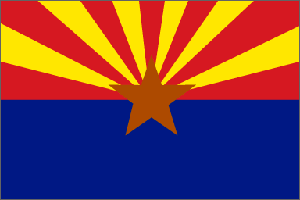Election 2008 Map


Latinos here make up about a fifth of the population, but are underrepresented at about a tenth of voters. They went for John Kerry by a healthy 60% in 2004. A concerted effort to register Latinos alone probably would have given Democrats the state in 2004, and should be a top priority for 2008.

Latinos in
All is not lost in


Electoral Votes: 10
Vote 2004: 55:44 Bush
Party ID: 44 Rep., 30 Dem., 26 Ind.
Governor: Janet Naplotanio (D)
Arizona has historically been one of the most conservative states in America, even producing the most conservative presidental candidate ever, Barry Goldwater in 1964. However, demographic trends and the fact that Arizonians elected a Democratic governor in 2002. Although several polls held the race close in 2004, Kerry lost by a disapointing 11 points. Despite that, on current trends Arizona is very much in play in 2008.
Arizona's conservativm is quite distinct from that of George Bush's. Arizonians value primarily tax-cutting, budget balancing fiscal conservatives, and not so much the Southern moral conservatives in power now. Should the Republicans nominate another Southern moralizer, such as a Bill Frist, Arizonians may warm to a fiscally resposible Democrat.
Demographic trends also favour a Democratic candidate. Arizona has also seen explosive growth in its Latino population in the past few years, and assuming the Democrats keep their historic advantage among minority groups this should put the state in play. Latinos made up 12% of Arizona's voters in 2004, and they voted for Kerry by 13 points. Latinos, however make up 25% of Arizona's voting age population and that number is set to rise rapidly. If Democrats can make a concerted effort to register latino voters in the state, that alone may win them the election. A Latino candidate at the top of the ticket may even expand their margins within the growing population.
Arizona's growing reputation as a retirement destination may also contribute to a Democratic victory in 2008. Arizona's seniors went to Bush in 2004, but by a smaller margin than the state as a whole. Many of the new retirees are from Blue states such as California and New York, and the Republicans may have a national problem on their hands with seniors in 2008 thanks to their fiddling with Social Security.
The Democrat's bigest ally may not be the particular demographic changes themselves, but the astonishing speed at which they are occuring. Arizona has a population growth rate almost triple the Unites States's average. At these rate Arizona's population will grow greatly by 2008, and many of the new arrivals will be Democratic voters. The challenge in Arizona is to assure these new arrivals will register and vote in the state. It is likely that the number of people who wanted Kerry as president was greater than 44 percent, but many of these people were not registered or did not vote as the Democrat's get out the vote effort was concentrated in Ohio, Flordia, and the other swing states. A good indication as to where the state is headed should come in 2006 when Governor Napolitano is up for reelection.